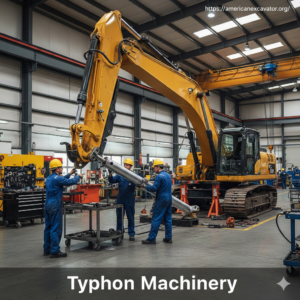Research has shown a significant surge in the adoption of mini excavators over the past few years. They’ve gone from being niche tools to key equipment across various industries. Their flexibility and effectiveness make them indispensable for jobs, from landscaping to urban development. However, operating these machines isn’t a child’s play. It requires a precise combination of knowledge, skill, and attention to safety protocols to avoid accidents and ensure successful outcomes.
For new users, navigating the complexities of the mini excavator operation can seem hard at first. But with the right guidance, you can unlock their full potential. This article will guide you step-by-step through the main safety rules and ways to work a mini excavator. We’ll help you start strong as you begin.
The Importance of Proper Training
The key to safe and effective mini excavator operation depends on one crucial element: comprehensive training. Don’t let their compact size fool you – these powerful machines pack a punch that demands respect and skill to handle safely. Lack of proper training could jeopardize the understanding of these operators regarding the dangers posed by these machines, thereby posing dangers at the workplace.
Learn more: Mini Excavator: Top 5 Benefits for Small-Scale Construction
Key Components and Controls

For a smooth mini excavator operation, new operators need to familiarize themselves with its main parts and control first. The key components of a mini excavator are:
- Operator’s Seat: Where the driver sits and uses the controls.
- Treads or Tires: These help a mini excavator move and stay steady on different ground types.
- Main Arm: The jointed arm used for digging, picking up items, and other jobs.
- Scoop: Attached to the arm’s end, it digs and moves materials.
- Turning Base: This part lets the seat and arm spin all the way around, helping work in tight spots.
The controls usually have joysticks to maneuver the arm parts and foot pedals to move the tracks or wheels. Knowing how to use these controls essential is for safe operation. By getting familiar with these main parts and controls, new users can safely make the most of these small but mighty machines.
Learn more: How Mini Excavators Improve Efficiency in Tight and Urban Spaces
Essential Pre-Op Checks for Your Mini Excavator
Before starting any task with a mini excavator, it is essential to perform a comprehensive pre-operational check. These pre-operational checks are not just a formality – they’re your first line of defense against accidents and equipment failures. These include:
Your Mini Excavator Safety Checklist
Fluid Levels:
- Engine oil: Your excavator’s lifeblood – check it first!
- Hydraulic fluid: Ensure it’s at the right level for smooth operation.
- Coolant: Don’t let your machine overheat – check the coolant.
- Fuel: Always start with a full tank for uninterrupted work.
Visual Inspection:
- Tires or tracks: Look for wear, damage, or loose parts.
- Attachments: Ensure they’re secure and in good condition.
- Structural components: Check for cracks, dents, or signs of stress.
Safety Features:
- Seatbelt: It’s there for a reason – make sure it’s functional.
- ROPS/FOPS: Verify the integrity of your rollover and falling object protection.
- Emergency stop: Test it – it could save your life one day.
Controls and Instruments:
- Gauges and warning lights: All should be operational and show normal readings.
- Joysticks and pedals: Ensure smooth movement without sticking.
Surrounding Area:
- Ground conditions: Assess for stability and potential hazards.
- Overhead obstacles: Look up – power lines are a serious danger.
Pro Tip: Create a laminated checklist and keep it in your excavator. It’s a simple step that can prevent major headaches – or worse.
By diligently performing these checks, you’re not just maintaining your equipment; you’re safeguarding lives and ensuring a productive workday.
Operating a Mini Excavator
Here are the steps to follow when operating a mini excavator:
Familiarize Yourself with the Manual:
It is recommended to start with the reading of the excavator manual to know the various features and controls of the excavator. It is essential to know the differences of every mini excavator model to be able to use the functions demanded for your project.
Entering the Cab:
To safely operate the mini excavator, one has to get into the cab of the mini excavator while observing the three-point contact rule. Fasten your seat belt, put the excavator in motion, and set the safety lock lever. In the case of an excavator with a standard ignition key and that of a digital keypad, the following are very important steps for safety:
Preparing to Drive:
Before moving, it is advisable to raise the stabilizer bar. The mini excavator features two control joysticks: the right stick is for the operation of the boom and the bucket rotation and the left stick is for the stick operation and the rotation of the excavator which is called the ‘swing’.
Locating Track Pedals:
To start off operating the mini excavator to move it, find the track pedals. Modify the engine speed and the stabilizer bar with the fluid control levers. To get a feel of the machine, one should ensure that they know all the controls of the machine.
Operating the Hand Controls:
The hand controls let you control the movement of the machine in the forward and backward direction. Mini Excavators are complex machines and are not easy to maneuver and control without proper training. Therefore, It is advisable to ensure that the operators are well-trained.
Starting Excavation:
To begin digging, retract the boom towards yourself and push the boom lever down until the teeth of the bucket touch the ground. Then, pulling the bucket back through the soil toward you is what is to be done next. It also can swing the boom to transfer the removed material to an ideal disposal area.
Prioritizing Safety in Mini Excavator Operation
When using a mini excavator, safety must come first. Every operator should follow these key practices:
- Weight Limits: Never exceed the machine’s stated load capacity. Going over can make the excavator tip, putting you and others at risk.
- Clear Sightlines: Always keep a good view of where you’re working. If you can’t see well, move the machine or get someone to help guide you.
- Firm Ground: Only run the excavator on flat, solid surfaces. Slopes or bumpy areas make tipping more likely. If needed, use supports or adjust the arm to stay safe.
- Watch Your Surroundings: Keep an eye out for dangers like power lines above, pipes below, and other machines nearby. It’s crucial to mark underground utilities before you start digging.
- Proper Shutdown: At day’s end, park on level ground, lower the arm, and set the bucket down. Turn off the engine, lock it up, and take the key to keep others from using it.
Before we conclude, For those looking for a strong yet small option for minor building jobs, the TYPHON TERROR X2 STORM Mini Excavator stands out. This compact digger is built to handle many tasks in gardens, farms, parks, roads, and beyond. It has a robust 18.4kW Perkins 403j-11 engine, ensuring smooth work and easy upkeep. Its features include a tight 360-degree turn radius, movable boom, and adjustable tracks, giving it great flexibility in tight spots. Plus, its user-friendly design and 500mm wide bucket make it good for both skilled workers and beginners. With the TYPHON TERROR X2 STORM, your small construction projects aren’t just finished – they’re done well and quickly

Figure 3: Image of the Typhon Terror X2 Storm Mini Excavator, showcasing its compact size and robust design
Wrapping Up
Mini excavators are powerful tools, but using them safely requires constant care and attention to detail. By sticking to these guidelines, operators can help prevent accidents and keep job sites safe for everyone.





